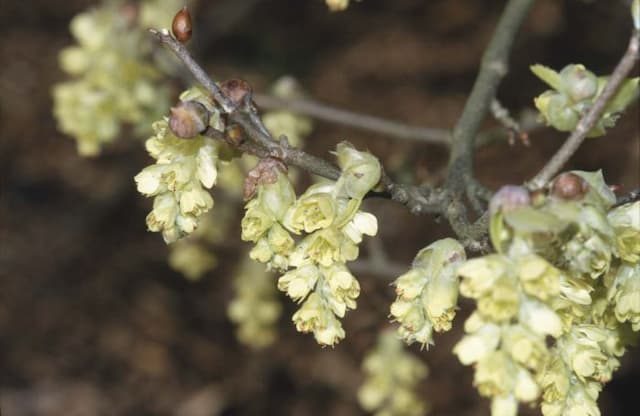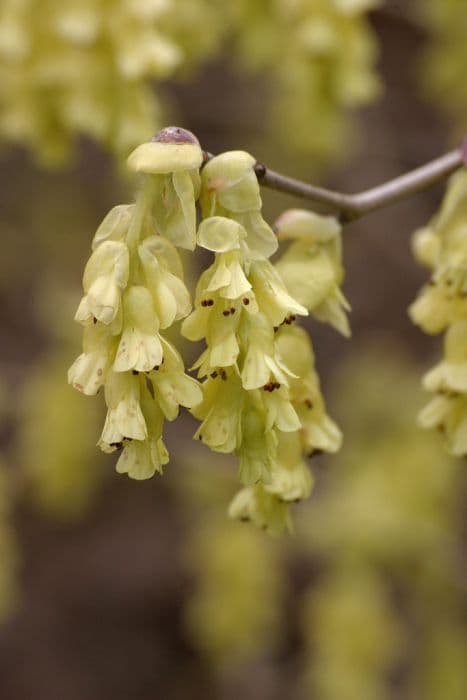Witch Hazel Hamamelis × intermedia 'Livia'

ABOUT
The plant commonly known as witch hazel 'Livia' has a striking appearance. It features large, broad leaves that are oval in shape and have wavy or slightly toothed edges. These leaves usually change colors with the seasons, taking on bold shades from green to yellow, and sometimes a bright red or orange, depending on the time of year. One of the most distinctive features of 'Livia' is its flowers. They bloom typically in the late winter to early spring when few other plants are flowering. The blooms are eye-catching, with long, ribbon-like petals that are a deep red or copper color, creating a dramatic contrast against the bare branches or the backdrop of the leaves. These slightly fragrant flowers curl and twist, adding to their visual interest and giving the plant a spidery appearance. After flowering, the plant produces seed capsules that split open in fall to reveal black seeds. The bark of 'Livia' is smooth and has an attractive grayish-brown color that provides winter interest when the leaves have fallen. It’s worth noting that the branches of the witch hazel 'Livia' can sometimes grow in a somewhat irregular, open pattern, giving each plant a unique structure. In summary, the witch hazel 'Livia' is a visually captivating plant that offers year-round interest with its changing leaf colors, unusual winter flowers, and attractive bark.
About this plant
 Names
NamesFamily
Hamamelidaceae
Synonyms
Witch Hazel, Hybrid Witch Hazel, Winterbloom
Common names
Hamamelis × intermedia 'Livia'.
 Toxicity
ToxicityTo humans
Witch hazel is generally considered non-toxic to humans. There is no significant evidence to suggest that Hamamelis × intermedia 'Livia', a cultivar of witch hazel, poses any toxic threat if ingested. However, as with many plants, individual allergies or sensitivities could potentially cause mild irritation or discomfort if parts of the plant are consumed or if the skin comes into direct contact with its sap.
To pets
Witch hazel is also not known to be toxic to pets. Ingesting parts of Hamamelis × intermedia 'Livia', or witch hazel, is unlikely to lead to poisoning in pets. Nonetheless, it's always best to keep an eye on your pet and prevent them from consuming plants, as individual animals might have sensitivities or could experience gastrointestinal upset from eating non-food items.
 Characteristics
CharacteristicsLife cycle
Perennials
Foliage type
Deciduous
Color of leaves
Green
Flower color
Red
Height
8-12 feet (2.4-3.7 meters)
Spread
8-12 feet (2.4-3.7 meters)
Plant type
Shrub
Hardiness zones
5-8
Native area
Cultivar
Benefits
 General Benefits
General Benefits- Attractive Flowers: Witch Hazel 'Livia' offers vibrant red flowers that brighten up winter landscapes.
- Fragrance: The plant's blooms emit a pleasant fragrance, providing sensory appeal to gardens.
- Seasonal Interest: Blooms in late winter to early spring, providing color when few other plants are flowering.
- Attracts Wildlife: Supports local ecosystems by providing nectar for pollinators such as bees.
- Low Maintenance: Once established, Witch Hazel 'Livia' requires minimal care, making it ideal for low-maintenance gardens.
- Tolerates a Range of Soil Types: Adaptable to various soil conditions, including clay, loam, and sand.
- Drought Tolerant: Exhibits a degree of drought resistance once fully established, reducing the need for frequent watering.
- Pest Resistance: Generally resistant to most pests, reducing the need for chemical interventions.
- Deciduous Interest: Exhibits attractive foliage and fall color, adding another layer of visual interest to the landscape.
- Architectural Plant: Its unique growth habit and structure can be used to create focal points in garden design.
 Medical Properties
Medical PropertiesThis plant is not used for medical purposes.
 Air-purifying Qualities
Air-purifying QualitiesThis plant is not specifically known for air purifying qualities.
 Other Uses
Other Uses- Photography Backdrop: The rich red flowers of witch hazel 'Livia' can serve as a beautiful and natural backdrop for outdoor photography sessions.
- Natural Fence: Dense, mature witch hazel 'Livia' can be used to create a privacy screen or natural boundary in gardens and yards.
- Erosion Control: Because of its well-developed root system, witch hazel 'Livia' can be planted on slopes to help prevent soil erosion.
- Wintertime Interest: Witch hazel 'Livia' is known for blooming in late winter; planting this shrub can add color to a garden when most other plants are dormant.
- Wildlife Shelter: The thick branches and foliage of witch hazel 'Livia' provide shelter for birds and other small wildlife during harsh weather.
- Ecological Support: This plant can be used to support local ecosystems by providing habitat and food sources for pollinators when in bloom.
- Artistic Inspiration: The unique blooms and growth habit of witch hazel 'Livia' can inspire artists and serve as subjects for paintings and other forms of art.
- Seasonal Celebrations: The branches of witch hazel 'Livia', with their vibrant flowers, can be used in floral displays for winter festivals and events.
- Education: Witch hazel 'Livia' can be used in educational settings to teach about plant biology and the changing seasons, as it is one of the few plants flowering in winter.
- Dramatic Foliage Display: In autumn, the foliage of witch hazel 'Livia' turns a striking yellow, gold, or red, adding a dramatic display of color to any landscape design.
Interesting Facts
 Feng Shui
Feng ShuiThe Witch Hazel is not used in Feng Shui practice.
 Zodiac Sign Compitability
Zodiac Sign CompitabilityThe Witch Hazel is not used in astrology practice.
 Plant Symbolism
Plant Symbolism- Healing: Hamamelis, commonly known as witch hazel, is well-known for its medicinal properties. 'Livia', as a variety of witch hazel, symbolizes healing due to the plant's use in traditional remedies and skin care treatments.
- Protection: The witch hazel has association with protection, often used in folklore to ward off negative influences or evil spirits, therefore 'Livia' can carry this symbolism of safeguarding and protection.
- Charm and Attraction: As witch hazel blooms during the late winter — one of the first plants to flower — 'Livia', with its attractive red flowers, embodies the idea of charm and the ability to stand out in adversity.
- New Beginnings: The early flowering of Hamamelis 'Livia' signifies new beginnings and the heralding of spring, representing hope and the start of a new cycle.
 Water
WaterThe Witch Hazel variety 'Livia' should be thoroughly watered when the top inch of soil feels dry to the touch, usually every 7-10 days, depending on climate conditions. During the growing season in spring and summer, it may need more frequent watering than in the fall and winter. Provide enough water to moisten the soil deeply, which might be around 1-2 gallons for a medium-sized shrub, ensuring it reaches the root zone. Over-watering or allowing the plant to sit in water can lead to root rot, so ensure proper drainage.
 Light
LightWitch Hazel 'Livia' prefers full sun to partial shade. It thrives in a location that receives at least 4-6 hours of direct sunlight each day, such as on the east or west side of a building where it can get morning or afternoon sun but is protected from the intense midday sun.
 Temperature
TemperatureWitch Hazel 'Livia' is quite cold-hardy and can tolerate temperatures down to about -10°F to -20°F, but its ideal growing temperature is between 30°F and 60°F. It can also withstand summer temperatures up to around 85°F, beyond which it may experience stress if not given adequate water.
 Pruning
PruningWitch Hazel 'Livia' benefits from pruning to shape the plant and remove any damaged or crossing branches. The best time to prune is in late winter or early spring before new growth begins. Prune sparingly, as the plant flowers on previous year's wood, and too much pruning can reduce flowering.
 Cleaning
CleaningAs needed
 Soil
SoilWitch hazel 'Livia' thrives best in well-drained, loamy soil rich in organic matter. A mix of two parts loam, one part peat or leaf mold, and one part sharp sand or perlite is ideal. The soil pH should be slightly acidic to neutral, ranging from 5.5 to 7.
 Repotting
RepottingWitch hazel 'Livia' is typically a slow-growing shrub and therefore does not require frequent repotting. It should be repotted when it outgrows its current container, which is generally every 3 to 5 years.
 Humidity & Misting
Humidity & MistingWitch hazel 'Livia' prefers average humidity conditions. It is adaptable and does not require special humidity considerations beyond what is typically found in its natural outdoor environment.
 Suitable locations
Suitable locationsIndoor
Witch Hazel 'Livia' needs bright light, cool temps indoor.
Outdoor
Plant Witch Hazel 'Livia' in sun/part shade, moist soil.
Hardiness zone
Witch hazel 'Livia' is suitable for USDA zones 5-8.
 Life cycle
Life cycleWitch Hazel 'Livia' begins its life cycle when a seed germinates in late spring, after experiencing a period of cold stratification. The seedling emerges and grows into a young plant, which focuses on developing a strong root system and foliage throughout its first few years. During this juvenile phase, the plant grows slowly, but as it matures it begins to develop its characteristic broad, spreading shape. After reaching maturity, usually within 4 to 6 years, Witch Hazel 'Livia' starts producing fragrant red to copper-red flowers typically in late winter or early spring before the leaves emerge. The plant then enters a long reproductive phase where each year it flowers, followed by the development of fruit capsules that split open in the fall to release seeds, thereby completing the cycle. Throughout its life, which can span several decades, Witch Hazel 'Livia' experiences annual cycles of growth, flowering, and dormancy.
 Propogation
PropogationPropogation time
Late winter to early spring
Hamamelis × intermedia 'Livia', commonly known as the hybrid witch hazel 'Livia', is typically propagated through softwood cuttings. The best time for taking cuttings is in late spring to early summer when new growth is still soft and pliable but well enough established to survive being cut. To propagate, a cutting of about 6 inches (15 centimeters) is taken from a healthy branch, making sure it includes at least one set of leaves. The lower leaves are removed, and the cut end is dipped in rooting hormone to encourage root development. The cutting is then placed in a well-draining potting mix, ensuring that the area where the leaves were removed is below the surface. The soil is kept moist but not waterlogged, and the cutting is placed in indirect light. With proper care, roots will develop within a few weeks, after which it can be gradually acclimatized to outdoor conditions.









